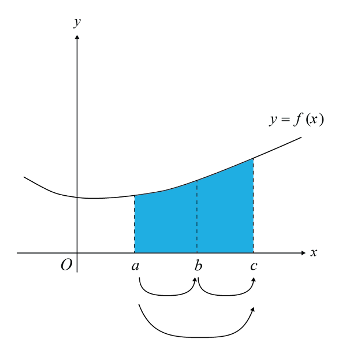Applications Of Integration
In this article, we will be learning about the different applications of integration. We will cover the following sub-topics:
- Evaluating definite integrals
- Properties of definite integrals
Evaluating Definite Integrals
Introduction
The notation \(\int_a^bf(x) \,dx \) denotes \(F(b) – F(a)\) where \(F\) is the antiderivative of \(f\).
Here \(a\) is called the lower bound and \(b\) is the upper bound.
We simply write it as,
\(\small{\begin{align*} \int_a^b f (x) \; dx &= \bigg [\,F (x)\,\bigg]_a^b \\ \\ &= F(b)- F(a) \end{align*}}\)
\(F(a)\) is obtained by substituting \(x = a \) into the function \(F\), while \(F(b)\) is obtained by substituting \( x = b \) into the function \(F\).
How is the notation \(\small{\displaystyle{\int_a^bf(x) \,dx}}\) read?
Integrate \(f(x)\) from \(a\) to \(b\) (from lower bound to upper bound), with respect to \(x\).
It represents the area under the curve \(f(x)\) from \(a\) to \(b\).
Properties Of Definite Integrals
First Property Of Definite Integrals
The definite integral of the scalar multiple of a function can be evaluated as such:
\(\small{\begin{align*} \int_a^b kf (x) \;dx = k \bigg[\;F (x)\;\bigg]_a^b \end{align*}}\)
Second Property Of Definite Integrals
The definite integral of the sum or difference of functions can be evaluated as such:
\(\small{\begin{align*} \int_a^b f (x) \;dx \pm \int_a^b g(x) \;dx = \int_a^b f (x) \pm g(x) \;dx \end{align*}}\)
Keep in mind that the lower bound \(a\) and upper bound \(b\) must be the same for both integrals.
Question 1:
Evaluate the following integrals.
\(\small{\mathrm{A.}\; \displaystyle{\int_1^2\,1+x+x^2\;dx}}\)
Solution:
\(\small{\begin{align*} \int_1^21+x+x^2\;dx &= \bigg[\; x+\frac{x^2}{2}+\frac{x^3}{3} \;\bigg]_1^2 & &\text{First, integrate the expression.} \\ \\ &= \bigg(\;2+\frac{4}{2}+\frac{8}{3}\;\bigg) - \bigg(\;1+ \frac{1}{2}+\frac{1}{3}\;\bigg) & &\text{Substitute} \; x = 2\; \text{and}\; x = 1. \\ \\ &= 6\frac{2}{3} - 1\frac{5}{6} & &\text{Subtract the expressions.} \\ \\ &= 4\frac{5}{6} & &\text{Evaluate.} \end{align*}}\)
\(\small{\mathrm{B.}\; \displaystyle{\int_0^{\tfrac{\pi}{6}} cos\;3x \;dx}}\)
Solution:
\(\small{\begin{align*} \int_0^{\tfrac{\pi}{6}} cos\;3x \;dx &= \bigg[\; \frac{sin\,3x}{3} \;\bigg]_0^{\tfrac{\pi}{6}} \\ \\ &= \bigg(\; \frac{sin\,\frac {\pi}{2}} {3} \;\bigg) - \bigg(\; \frac {sin\,0} {3} \;\bigg)\\ \\ &= \frac {1}{3} - 0 \\ \\ &= \frac {1}{3} \end{align*}}\)
\(\small{\mathrm{C.}\; \displaystyle{\int_2^3 \frac{2}{2x-3} \;dx}}\)
Solution:
\(\small{\begin{align*} \int_2^3 \frac{2}{2x-3} \;dx &= \bigg[\; \frac{2\,\ln (2x-3)}{2} \;\bigg]_2^6 \\ \\ &= \bigg[\; \ln (2x-3) \;\bigg]_2^6 \\ \\ &= \big(\; \ln (2\times6-3) \;\big) - \big(\; \ln (2\times2-3) \;\big) \\ \\ &= \big(\; \ln (12-3) \;\big) - \big(\; \ln (4-3) \;\big) \\ \\ &= \ln 9 - \ln 1 \\ \\ &= \ln 9 - 0 \\ \\ &= \ln 9 \end{align*}}\)
Question 2:
Evaluate \(\small{\displaystyle{\int_1^2 1 +x^2 \;dx}}\)
Solution:
\(\small{\begin{align*} \int_1^2 1 +x^2 \;dx &= \bigg[\; x+\frac{x^3}{3}\;\bigg]_1^3 \\ \\ &= \bigg(\; 3+\frac{27}{3}\;\bigg)-\bigg(\; 1+\frac{1}{3}\;\bigg) \\ \\ &= 12 -1\frac{1}{3} \\ \\ &= 10\frac{2}{3} \end{align*}}\)
Question 3:
Evaluate \(\small{\displaystyle{\int_{\tfrac{\pi}{12}}^{\tfrac {\pi}{6}}3\;sec^2\,2x\;dx }}\), leaving your answer in exact form.
Solution:
\(\small{\begin{align*} \int_{\tfrac{\pi}{12}}^{\tfrac {\pi}{6}}3\;sec^2 2x\;dx &= \bigg[\; \frac{3 \;tan \;2x}{2} \;\bigg]_{\tfrac{\pi}{12}}^{\tfrac {\pi}{6}} \\ \\ &= \bigg(\; \frac{3 \;tan \;{\frac{\pi}{3}}}{2} \;\bigg) - \bigg(\; \frac{3 \;tan \;{\frac{\pi}{6}}}{2} \;\bigg) \\ \\ &= \frac { 3\sqrt{3} } {2} - \frac{3}{2} \cdot \frac{\sqrt{3}}{3} \\ \\ &= \frac{2\sqrt{3}}{2} \\ \\ &= \sqrt{3} \end{align*}}\)
Third Property Of Definite Integrals
If the lower bound and upper bound are equal in value, the result of the definite integral is \(0\).
\(\small{\begin{align*} \int_ a^a f(x)\; dx &= \bigg[\;F(x)\;\bigg]_a^a \\ \\ &= F(a) - F(a) \\ \\ &= 0 \end{align*}}\)
Fourth Property of Definite Integrals
If the lower bound and upper bound are swapped, the result of the new definite integral is equal in value but opposite in sign (i.e., positive vs. negative) compared to the original definite integral.
\(\small{\begin{align*} \int_ b^a f(x) \;dx &= \bigg[\;F(x)\;\bigg]_b^a \\ \\ &= F(a) - F(b) \\ \\ &= -\bigg(\;F(b) - F(a)\;\bigg) \\ \\ &= -\bigg[\;F(x)\;\bigg]_a^b \\ \\ &= -\int_ a^b f(x)\, dx \end{align*}}\)
Fifth Property of Definite Integrals
For definite integrals of the same function, where the upper bound of the first integral is equal in value to the lower bound of the second integral:
\(\small{\begin{align*} \int_ a^b f(x) \;dx + \int_ b^c f(x) \;dx = \int_ a^c f(x) \;dx \end{align*}}\)
Graphically,

Conclusion
In this article, we learned about definite integrals and how they are different from indefinite integrals. We also learned the five different properties associated with definite integrals.
Keep improving! Keep learning!
| Continue Learning | |
|---|---|
| Introduction To Differentiation | Applications Of Differentiation |
| Differentiation Of Exponential And Logarithmic Functions | Integration Techniques |
| Applications Of Integration | |
 SG
SG  VN
VN 










